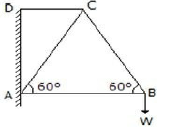A cable with a uniformly distributed load per horizontal meter run will take the following shape
Straight line
Parabola
Hyperbola
Elliptical
Correct Answer :
B. Parabola
Related Questions
A body will begin to move down an inclined plane if the angle of inclination of the plane is _________ the angle of friction.
Equal to
Less than
Greater than
None of these
A number of forces acting at a point will be in equilibrium, if
All the forces are equally inclined
Sum of all the forces is zero
Sum of resolved parts in the vertical direction is zero (i.e. ΣV = 0)
None of these
The motion of a particle round a fixed axis is
Translatory
Rotary
Circular
Translatory as well as rotary
Moment of inertia of a circular section about an axis perpendicular to the section is
πd3/16
πd3/32
πd4/32
πd4/64
In determining stresses in frames by methods of sections, the frame is divided into two parts by an imaginary section drawn in such a way as not to cut more than
Two members with unknown forces of the frame
Three members with unknown forces of the frame
Four members with unknown forces of the frame
Three members with known forces of the frame
The resultant of two forces P and Q (such that P > Q) acting along the same straight line, but in opposite direction, is given by
P + Q
P - Q
P / Q
Q / P
The moment of inertia of a rectangular section 3 cm wide and 4 cm deep about X-X axis is
9 cm4
12 cm4
16 cm4
20 cm4
The term 'Centroid' is
The same as centre of gravity
The point of suspension
The point of application of the resultant of all the forces tending to cause a body to rotate about a certain axis
None of the above
Whenever a force acts on a body and the body undergoes a displacement, then
Work is said to be done
Power is being transmitted
Body has kinetic energy of translation
None of these
D' Alembert's principle is used for
Reducing the problem of kinetics to equivalent statics problem
Determining stresses in the truss
Stability of floating bodies
Designing safe structures
The bodies which rebound after impact are called
Inelastic bodies
Elastic bodies
Neither elastic nor inelastic bodies
None of these
In a framed structure, as shown in the below figure, the force in the member AB is __________ the force in member AC. 
Half
Equal to
Double
None of these
The equivalent length of a simple pendulum which gives the same frequency as compound pendulum is
h/(kG² + h²)
(kG² + h²)/h
h²/(kG² + h²)
(kG² + h²)/h²
The linear acceleration (a) of a body rotating along a circular path of radius (r) with an angular acceleration of α rad/s2, is
a = α/ r
a = α.r
a = r / α
None of these
Tension in the cable supporting a lift is more when the lift is moving __________ with an acceleration.
Upwards
Downwards
Horizontal
None of these
The moment of inertia of a solid cylinder of mass m, radius r and length l about the longitudinal axis or polar axis is
mr2/2
mr2/4
mr2/6
mr2/8
In a screw jack, the effort required to lift the load is given by (where W = Load lifted, α = Helix angle, and φ = Angle of friction.)
P = W tan (α - φ)
P = W tan (α + φ)
P = W tan (φ - α)
P = W cos (α + φ)
The velocity ratio of a differential wheel and axle with D as the diameter of effort wheel and d1 and d2 as the diameters of larger and smaller axles respectively, is
D/(d₁ + d₂)
D/(d₁ - d₂)
2D/(d₁ + d₂)
2D/(d₁ - d₂)
Moment of inertia of a rectangular section having width (b) and depth (d) about an axis passing through its C.G. and parallel to the depth (d), is
db3/12
bd³/12
db³/36
bd³/36
The potential energy of a vertically raised body is __________ the kinetic energy of a vertically falling body.
Equal to
Less than
Greater than
None of these
Tangent of angle of friction is equal to
Kinetic friction
Limiting friction
Angle of repose
Coefficient of friction
The periodic time of one oscillation for a simple pendulum is (where l = Length of the pendulum.)
(1/2π). √(l/g)
(1/2π). √(g/l)
2π. √(l/g)
None of these
Joule is the unit of
Force
Work
Power
Velocity
A smooth cylinder lying on a __________ is in neutral equilibrium.
Curved surface
Convex surface
Horizontal surface
None of these
The coefficient of restitution for inelastic bodies is
Zero
One
Between zero and one
More than one
The algebraic sum of moments of the forces forming couple about any point in their plane is
Equal to the moment of the couple
Constant
Both of above are correct
Both of above are wrong
Limiting force of friction is the
Tangent of angle between normal reaction and the resultant of normal reaction and limiting friction
Ratio of limiting friction and normal reaction
The friction force acting when the body is just about to move
The friction force acting when the body is in motion
A force is completely defined when we specify
Magnitude
Direction
Point of application
All of the above
The moment of a force
Is the turning effect produced by a force, on the body, on which it acts
Is equal to the product of force acting on the body and the perpendicular distance of a point and the line of action of the force
Is equal to twice the area of the triangle, whose base is the line representing the force and whose vertex is the point, about which the moment is taken
All of the above
The angle of inclination of the plane at which the body begins to move down the plane, is called
Angle of friction
Angle of repose
Angle of projection
None of these
